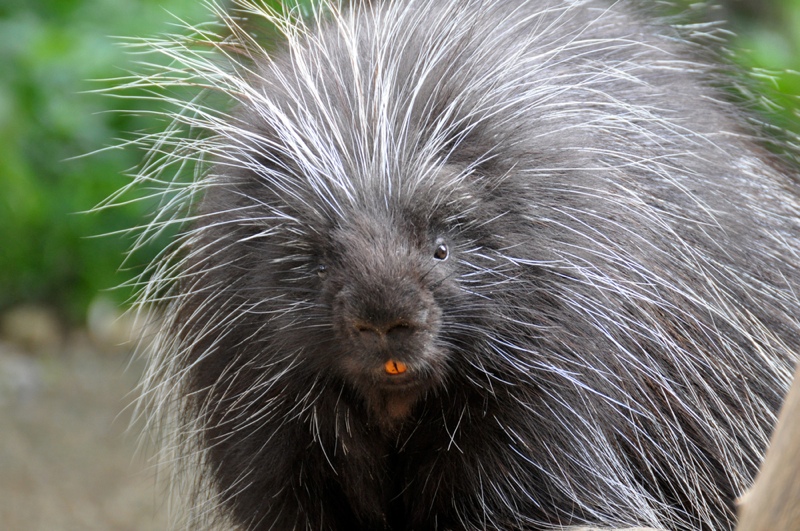Facts About Porcupines

Porcupines are large, slow-moving rodents with sharp quills on their backs. They are found on every continent except Antarctica. Scientists group porcupines into two groups: Old World porcupines, which are found in Africa, Europe and Asia; and New World porcupines, which are found in North, Central, and South America. The North American porcupine is the only species found in the United States and Canada.
Sharp quills
All porcupines have a few traits in common. The most obvious trait is the long, sharp quills that cover their bodies. Some quills can get up to a foot (30 centimeters) long, like those on the Africa's crested porcupine, according to National Geographic.
Porcupines use the quills as a defense. They make shake them, which makes them rattle, as a warning to potential predators. If that doesn't work, they may charge backwards into the predator. The quills are loosely attached but cannot be thrown or projected, according to the Animal Diversity Web. Some quills have scales or barbs that make them very hard to remove. Once a quill is lost, it isn't lost forever. They grow back over time. A North American porcupine can have 30,000 or more quills, according to National Geographic.
Size
The largest porcupine is the North African crested porcupine. It grows up to 36 inches (90 centimeters) long. The smallest is the Bahia hairy dwarf porcupine. It grows up to 15 inches (38 cm) long. Porcupines weigh 2.5 to 77 lbs. (1.2 to 35 kilograms), depending on species, and their tails can grow up to 8 to 12 inches (20 to 30 cm), according to the San Diego Zoo.
The length of quills varies by type. New World porcupines have small quills that are around 4 inches (10 cm) long, while Old World porcupines have quills that can grow up to 20 inches (51 cm) long, though there are some exceptions.
Habitat
In general, porcupines live in just about any terrain, including deserts, grasslands, mountains, rainforests and forests. Dens in tree branches or tangles of roots, rock crevices, brush or logs are the porcupine's home.
Habits
Porcupines are nocturnal, which means they are active during the night and sleep during the day. During the night, they forage for food. New World porcupines spend their time in the trees, while Old World porcupines stay on the ground.
Get the world’s most fascinating discoveries delivered straight to your inbox.
Porcupines aren't really social. Both types of porcupines are typically solitary, though New World porcupines may pair up. A mother and her young is considered a family group called a prickle.
Diet
Porcupines are herbivores. This means they eat mostly vegetation. Some porcupines love wood and eat a lot of bark and stems. They also eat nuts, tubers, seeds, grass, leaves, fruit and buds.
Though they don't eat meat, porcupines chew on bones to sharpen their teeth. Bones also give them important minerals, like salt and calcium, to keep them healthy. Porcupines are also known to eat bugs and small lizards every now and then.
Offspring
Female porcupines carry their young for a gestation period of 16 to 31 weeks, depending on species, and give birth to one to three babies at a time. Baby porcupines are called porcupettes.
Porcupettes are about 3 percent of mother's weight at birth, according to the San Diego Zoo. At birth, they have soft quills, which harden in a few days. Porcupettes mature at 9 months to 2.5 years, depending on species and can live up to 15 years in the wild.
Classification/taxonomy
New World porcupines make up the Erethizontidae family, which comprises four genera and 12 species. There are 11 species, in three genera, of Old World porcupines in the Hystricidae family.
This is the classification of the North American porcupine, according to Integrated Taxonomic Information System (ITIS):
Kingdom: Animalia Subkingdom: Bilateria Infrakingdom: Deuterostomia Phylum: Chordata Subphylum: Vertebrata Infraphylum: Gnathostomata Superclass: Tetrapoda Class: Mammalia Subclass: Theria Infraclass: Eutheria Order: Rodentia Suborder: Hystricomorpha Infraorder: Hystricognathi Family: Erethizontidae Subfamily: Erethizontinae Genus: Erethizon Species: Erethizon dorsatus, with seven subspecies
Conservation status
Porcupines are listed as least concern or as vulnerable by the International Union for Conservation of Nature (IUCN), depending on the species. Species listed as vulnerable include the Phillipine porcupine and the bristle-spined porcupine. There are currently no species listed as endangered, though some species don't have enough data to come to decision on its status.
Additional Resources



